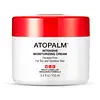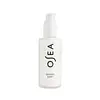What's inside
What's inside
 Key Ingredients
Key Ingredients

 Benefits
Benefits

 Concerns
Concerns

 Ingredients Side-by-side
Ingredients Side-by-side

Water
Skin ConditioningGlycerin
HumectantPropanediol
SolventMyristoyl/Palmitoyl Oxostearamide/Arachamide Mea
Skin ConditioningCaprylic/Capric Triglyceride
MaskingCetearyl Alcohol
EmollientGlyceryl Stearate
EmollientPolyglyceryl-10 Distearate
EmulsifyingVitis Vinifera Seed Oil
EmollientSorbitan Stearate
EmulsifyingPortulaca Oleracea Extract
Skin ConditioningDimethicone
EmollientHydrogenated Vegetable Oil
EmollientOlea Europaea Fruit Oil
MaskingTocopheryl Acetate
AntioxidantSimmondsia Chinensis Seed Oil
EmollientSodium Hyaluronate
HumectantPhytosterols
Skin ConditioningCarbomer
Emulsion StabilisingCaprylyl Glycol
Emollient1,2-Hexanediol
Skin ConditioningArginine
MaskingStearic Acid
CleansingAllantoin
Skin ConditioningParfum
MaskingTropolone
Skin ConditioningWater, Glycerin, Propanediol, Myristoyl/Palmitoyl Oxostearamide/Arachamide Mea, Caprylic/Capric Triglyceride, Cetearyl Alcohol, Glyceryl Stearate, Polyglyceryl-10 Distearate, Vitis Vinifera Seed Oil, Sorbitan Stearate, Portulaca Oleracea Extract, Dimethicone, Hydrogenated Vegetable Oil, Olea Europaea Fruit Oil, Tocopheryl Acetate, Simmondsia Chinensis Seed Oil, Sodium Hyaluronate, Phytosterols, Carbomer, Caprylyl Glycol, 1,2-Hexanediol, Arginine, Stearic Acid, Allantoin, Parfum, Tropolone
Water
Skin ConditioningGigartina Skottsbergii Extract
Skin ConditioningMacrocystis Pyrifera
Algae
Skin ConditioningUndaria Pinnatifida Vesicles
HumectantVitis Vinifera Seed Oil
EmollientCaprylic/Capric Triglyceride
MaskingGlycerin
HumectantPropanediol
SolventCetearyl Olivate
Simmondsia Chinensis Seed Oil
EmollientSorbitan Olivate
EmulsifyingMelaleuca Alternifolia Leaf Oil
AntioxidantSaccharomyces/Copper Ferment
Skin ConditioningRosmarinus Officinalis Leaf Oil
MaskingSaccharomyces/Manganese Ferment
Skin ConditioningLavandula Angustifolia Oil
MaskingSaccharomyces/Zinc Ferment
Skin ConditioningMyrtus Communis Leaf Oil
PerfumingGlyceryl Stearate
EmollientThymus Vulgaris Oil
MaskingCetearyl Alcohol
EmollientCupressus Sempervirens Oil
MaskingStearic Acid
CleansingCitrus Grandis Peel Oil
MaskingSodium Lauroyl Glutamate
Xanthan Gum
EmulsifyingCyamopsis Tetragonoloba Gum
Emulsion StabilisingCitric Acid
BufferingLonicera Caprifolium Extract
AstringentLonicera Japonica Callus Extract
Skin ProtectingWater, Gigartina Skottsbergii Extract, Macrocystis Pyrifera, Algae, Undaria Pinnatifida Vesicles, Vitis Vinifera Seed Oil, Caprylic/Capric Triglyceride, Glycerin, Propanediol, Cetearyl Olivate, Simmondsia Chinensis Seed Oil, Sorbitan Olivate, Melaleuca Alternifolia Leaf Oil, Saccharomyces/Copper Ferment, Rosmarinus Officinalis Leaf Oil, Saccharomyces/Manganese Ferment, Lavandula Angustifolia Oil, Saccharomyces/Zinc Ferment, Myrtus Communis Leaf Oil, Glyceryl Stearate, Thymus Vulgaris Oil, Cetearyl Alcohol, Cupressus Sempervirens Oil, Stearic Acid, Citrus Grandis Peel Oil, Sodium Lauroyl Glutamate, Xanthan Gum, Cyamopsis Tetragonoloba Gum, Citric Acid, Lonicera Caprifolium Extract, Lonicera Japonica Callus Extract
 Reviews
Reviews

Ingredients Explained
These ingredients are found in both products.
Ingredients higher up in an ingredient list are typically present in a larger amount.
This ingredient is an emollient, solvent, and texture enhancer. It is considered a skin-softener by helping the skin prevent moisture loss.
It helps thicken a product's formula and makes it easier to spread by dissolving clumping compounds.
Caprylic Triglyceride is made by combining glycerin with coconut oil, forming a clear liquid.
While there is an assumption Caprylic Triglyceride can clog pores due to it being derived from coconut oil, there is no research supporting this.
Learn more about Caprylic/Capric TriglycerideCetearyl alcohol is a mixture of two fatty alcohols: cetyl alcohol and stearyl alcohol. It is mainly used as an emulsifier. Emulsifiers help prevent the separation of oils and products. Due to its composition, it can also be used to thicken a product or help create foam.
Cetearyl alcohol is an emollient. Emollients help soothe and hydrate the skin by trapping moisture.
Studies show Cetearyl alcohol is non-toxic and non-irritating. The FDA allows products labeled "alcohol-free" to have fatty alcohols.
This ingredient is usually derived from plant oils such as palm, vegetable, or coconut oils. There is debate on whether this ingredient will cause acne.
Due to the fatty acid base, this ingredient may not be Malassezia folliculitis safe.
Learn more about Cetearyl AlcoholGlycerin is already naturally found in your skin. It helps moisturize and protect your skin.
A study from 2016 found glycerin to be more effective as a humectant than AHAs and hyaluronic acid.
As a humectant, it helps the skin stay hydrated by pulling moisture to your skin. The low molecular weight of glycerin allows it to pull moisture into the deeper layers of your skin.
Hydrated skin improves your skin barrier; Your skin barrier helps protect against irritants and bacteria.
Glycerin has also been found to have antimicrobial and antiviral properties. Due to these properties, glycerin is often used in wound and burn treatments.
In cosmetics, glycerin is usually derived from plants such as soybean or palm. However, it can also be sourced from animals, such as tallow or animal fat.
This ingredient is organic, colorless, odorless, and non-toxic.
Glycerin is the name for this ingredient in American English. British English uses Glycerol/Glycerine.
Learn more about GlycerinGlyceryl Stearate is a mix of glycerin and stearic acid.
It is used to stabilize the mixing of water and oil ingredients. By preventing these ingredients from separating, it can help elongate shelf life. It can also help thicken the product's texture.
As an emollient, it helps soften skin and supports barrier-replenishing ingredients.
In cosmetics, Glyceryl Stearate is often made from vegetable oils or synthetically produced.
This ingredient may not be fungal-acne safe
Fun fact: The human body also creates Glyceryl Stearate naturally.
Learn more about Glyceryl StearatePropanediol is an all-star ingredient. It softens, hydrates, and smooths the skin.
It’s often used to:
Propanediol is not likely to cause sensitivity and considered safe to use. It is derived from corn or petroleum with a clear color and no scent.
Learn more about PropanediolThis oil comes from the seeds of the desert shrub called Jojoba. It is more commonly known as jojoba oil, a non-comedogenic oil.
Jojoba oil does not contain fragrance and has many fatty-acids, making it a great soothing ingredient.
It also contains Vitamin E, a great moisturizing ingredient. Vitamin E is also an antioxidant and protects your skin against oxidative damage.
This ingredient humectant properties, meaning it helps draw moisture from the air. This helps keep your skin hydrated.
While jojoba has antibacterial properties, it is only able to kill some strains of bacteria.
Studies also show it helps in wound healing. In fact, Indigenous cultures have used jojoba as a moisturizer and to help treat burns for centuries.
Fun fact: Jojoba oil similar to natural human skin sebum, so it has a great effect on dry skin. It is also promising with helping to regulate sebum production.
Due to its fatty acid content, Jojoba oil may not be fungal acne safe. We recommend speaking with a professional if you have any concerns.
Learn more about Simmondsia Chinensis Seed OilStearic Acid is a fatty acid. It is an emollient, emulsifier, and texture enhancer.
As an emollient, stearic acid helps soften skin. It aids the skin's protective barrier by preventing water loss. It also provides a gentle cleansing effect without stripping away natural oils.
Stearic acid may also be used to enhance the texture of products. It can add volume and stabilize ingredients such as water and oil. This can help water and oil ingredients from separating.
Sources of stearic acid include animal or vegetable fats/oils such as coconut or shea. It can be naturally found in butter, cocoa butter, shea butter, vegetable fats, and animal tallow.
This ingredient may not be Malassezia folliculitis, or fungal-acne safe.
Learn more about Stearic AcidVitis Vinifera Seed Oil comes from the grape vine. Grape seeds are a byproduct of creating grape juice or wine.
The components of grape seeds have many skin benefits. Research has found it to be antimicrobial and anti-inflammatory. It also contains many potent antioxidants such as Vitamin E , Vitamin C, proanthocyanidins, polyphenols, flavonoids, and anthocyanins. Proanthocyanidin has been shown to help even out skin tone.
Antioxidants help fight free-radical molecules. Free-radical molecules are capable of damaging our cells and other genetic material. Antioxidants help stabilize free-radicals by donating extra electrons. Grape seed extract may help reduce the signs of aging.
The antimicrobial properties of grape seed may help treat acne. However, more research is needed to support this claim.
Grape seed has also been found to help absorb UV rays. Grape seed extract should not replace your sunscreen.
The fatty acids of grape seed oil give it emollient properties. Emollients help soothe and soften your skin by creating a film. This film traps moisture within, keeping your skin hydrated.
Learn more about Vitis Vinifera Seed OilWater. It's the most common cosmetic ingredient of all. You'll usually see it at the top of ingredient lists, meaning that it makes up the largest part of the product.
So why is it so popular? Water most often acts as a solvent - this means that it helps dissolve other ingredients into the formulation.
You'll also recognize water as that liquid we all need to stay alive. If you see this, drink a glass of water. Stay hydrated!
Learn more about Water